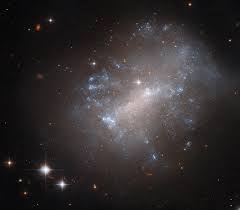Irregular Galaxy : Image Captured By Hubble Space Telescope

The Hubble Space Telescope recently captured an image of the irregular galaxy ESO 300-16, located at a distance of 28.7 million lightyears in the southern constellation of Eridanus.
- An irregular galaxy is a galaxy that does not have a distinct regular shape, like a spiral or an elliptical galaxy.
- They range from dwarf irregular galaxies with 100 million times the Sun’s mass to large ones weighing 10 billion solar masses.
- They also contain abundant amounts of gas and dust.
- There are many ways in which an irregular galaxy can be formed.
- For example, one can result from a collision between galaxies.
- When this happens, gravitational forces between separate galaxies interact, which causes an irregular type of rotation.
- A young galaxy can also take an irregular form, suggesting that it has not yet reached a symmetrical rotation.
- Irregular galaxies born from galaxy interactions or collisions typically host a mix of older and younger stars.
Hubble Space Telescope:
- It was built under the supervision of the National Aeronautics and Space Administration (NASA) of the United States and was named after Edwin Hubble, the foremost American astronomer of the 20th century.
- The HST was placed into orbit about 600 km (370 miles) above Earth by the crew of the space shuttle Discovery on April 25, 1990.




